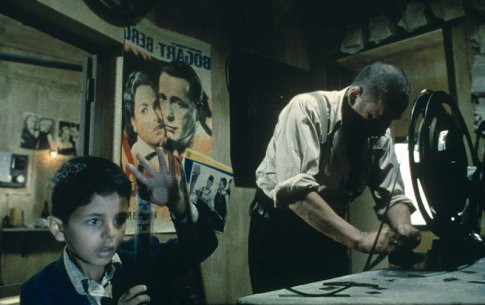Death of the projectionist and the rise of McCinema
Since I can remember I’ve been in love with film, I’ve worked in video stores and watched so many films that I can’t even remember how many I’ve watched. Since a year I’ve been working at one of the oldest and smallest art-house cinemas in Amsterdam: Filmtheater de Uitkijk. This tiny cinema at the Prinsengracht is run by a small group of students and they are in charge of everything. The cinema breaths a French avant-garde look and has 86 seats, including a cosy service balcony. Next year Filmtheater de Uitkijk will celebrate it’s 100-year anniversary and this calls for a celebration! But I doubt that celebrating is the right word here. Although we will celebrate 100 years of film, we will also mourn the death of something or rather someone who we love dearly. Someone who has always been there but who remains hidden behind a small window in the back of the room. Someone who is always watching, adjusting and constantly checking, so the moviegoers have the perfect film experience. Some call him the bassist of the cinema: quiet, mysterious but indispensable: the projectionist.

In the Netherlands there is a state funded project called Cinema Digitaal (Cinema Digital) where smaller cinema have the opportunity to replace their old 35 mm projectors with state of the art digital projectors. It is a huge operation and almost all the cinemas in the Netherlands participate. With this new digital projector it is possible for smaller cinemas to buy bigger films, play 3D and even play football games and operas from across the world. The manufacturers and the film distributors push this digital revolution to the max and if you don’t participate you are simply left behind. Last week I received a letter from one of the leading digital projector manufacturers saying: “Our projector will give your cinema the freedom to give your audience what they want!” really…..?
In the Oscar winning film Cinema Paradiso director Giuseppe Tornatore tells the story of an old projectionist named Alfredo, who teaches his nephew Salvatore the art of the projectionist. Unfortunately the cinema burns down and Alfredo is blinded by the accident. Salvatore becomes a director and after many years he returns to his village for Alfredo’s funeral. Alfredo has left Salvatore with a film canister containing all the love scenes from all the films the local church didn’t approve off over the years, showing us that cinematic love never dies. Unfortunately it does.
The Pathé multiplexes in Amsterdam have around 8500 seats and more than 40 screens. Only one central control room automatically runs all the films in digital format on these screens. With just a press on the button the lights will go down and the film starts on all the screens. This means the end of the projectionist because in a few years they are not needed anymore. Dutch film journalist Thomas Leeflang compares this situation with the rise of the sound film in 1927. Back then cinema orchestras played live music during the film. Critics thought that the audiences would never enjoy non-live music but after a few years nearly all the orchestras were gone. Nowadays few people can tell the difference between digital film and 35 mm.
Together with the rise of digital cinema, there has been another interesting development in cinemas. The introduction of the unlimited pass, with these passes moviegoers can see as many films as they want for a fixed price of 17 euro each month. I can’t help seeing a parallel with the big fast food chains, let me explain. When you enter a multiplex like Pathé Arena you get your ticket, and move (if you want to or not) past the popcorn, beverages and chocolate. You then watch the film and exit through another hall where you have the choice to leave the cinema or get in line for another film. There is no room to sit and talk about the film you just saw. It is designed just like a fast food restaurant to serve the customer and to make room for the next one as soon as possible.
Considering this it’s hard to believe that the projector manufacturer is telling the truth when they say: Our projector will give your cinema the freedom to give your audience what they want!” But what does the audience want? More Green Lantern, more Sex and the City, more Bayham?
Luckily for moviegoers in Amsterdam there is a healthy group of cinemas promoting quality films and I hope people will still find their way to these cinemas in the coming years. In a few years these cinemas will also only be able to show film in a digital format and the old 35 mm projectors will be gone.
The digital age has given us so much and made our lives so much easier but sometimes this doesn’t have to be a good thing. I do think that the digitization of cinemas is a development that could be very beneficial for art-house cinemas, I just mourn the death of somebody I hold very dear and who symbolizes the mystique cinema and film have. So next time you are in a cinema ask an employee if you could speak to the projectionist maybe he can give you a tour. I would love to let you see what film really feels and smells like.
A small documentary about projectionists in Amsterdam (in Dutch)